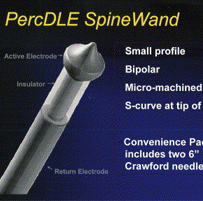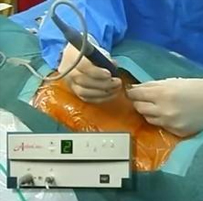The procedure is performed under x-ray guidance to accurately place a needle into the disc. Using this minimally invasive approach, a small pathway is made into the disc and a precisely engineered device, known as a SpineWand surgical device, is then inserted through the needle into the center of the disc. The device utilizes Coblation technology to dissolve tissue while preserving nearby healthy tissue.
The removal of nucleus tissue relieves pressure on the protective ring around the disc or annulus, typically allowing the bulge to recede, so that the disc no longer irritates the nearby nerve root. Normally, the entire procedure takes less than an hour, and the patient can leave the medical facility one to two hours later, with no overnight hospital stay required.
A cervical Nucleoplasty is performed for pain that is caused by damaged intervertebral discs. The aim of the procedure is to reduce pressure on the small nerves that are found in the annulus fibrosus (Hard fibrous covering the inner gel - nucleus) . This is done by shrinking the nucleus pulposus (Centrally located gel). The modality used for this is similar to radiofrequency rhizotomies, but a device is used which utilises coblation technology to dissolve tissue without damage to nearby normal structures.
The reason why your specialist at PCI performs this procedure and not a more invasive operation is because he or she is trying to be as conservative as possible in treating your condition. The aim is to treat your symptoms without resorting to a more invasive operation.
When undergoing this procedure, you will be lying on your back on bolsters or pillows. Your specialist will use an X-ray machine to guide the needle that is used to do the procedure with. A patented plasma device is then inserted through the needle into the disc, whereby excess tissue is removed. Removing some of the tissue from the center of the disc causes a reduction in intra-discal pressure, which in turn eases symptoms.








